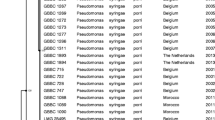Abstract
A necrotic leaf disease of leek (Allium ampeloprasum Porrum Group) is reported in Australia for the first time. The fluorescent pseudomonad consistently associated with diseased tissue was identified as Pseudomonas syringae by LOPAT tests (+,−,−,−,+), carbon utilisation, bean and lemon inoculations and fatty acid methyl ester analysis. It was confirmed as P. syringae pv. porri by pathogenicity to leeks, bulb onions, spring onions, shallots and garlic, and by genetic analysis using 16S rDNA PCR, REP, ERIC and BOX PCR, and IS50 PCR. Comparison with reference strains of pv. porri from other countries showed similarity to known strains of pv. porri. The Australian leek strains were generally uniform in their biochemical reactions although three strains tested varied in their pathogenicity to other Allium spp. and varied from published data. All Australian strains shared the same genetic profile with strains from New Zealand, France and California. However, Japanese strains from leek and onion were distinct from the Australian strains and those from New Zealand, France and California. Data strongly support the hypothesis that the pathogen is seed-borne.
Similar content being viewed by others
References
Fahy PC, Hayward AC (1983) Media and methods for isolation and diagnostic tests. In PC Fahy GJ Persley (eds.), Plant Bacterial Diseases: A Diagnostic Guide. Academic Press, Sydney pp 337–378
Gardan L, Shafik H, Belouin S, Broch R, Grimont F, Grimont PAD (1999) DNA relatedness among pathovars of Pseudomonas syringae and description of Pseudomonas tremae sp. Nov. and Pseudomonas cannabina sp. nov. (ex Sutic and Dowson 1959) International Journal of Systematic Bacteriology 49: 469–478
Goto M (1972) Bacterial leaf blight of onion in Japan Plant Disease Reporter 56: 490–493
Hale CN (1975) Bacteriosis of leeks in New Zealand New Zealand Journal of Agricultural Research 18: 251–254
Hayward AC (1960) A method for characterising Pseudomonas solanacearum Nature 186: 405–406
King EO, Ward MK, Raney DE (1954) Two simple media for the demonstration of pyocyanin and fluorescein Journal of Laboratory and Clinical Medicine 44: 301–307
Koeuth T, Versalovic J, Lupski J (1995). Differential subsequence conservation of interspersed repetitive Streptococcus pneumonia BOX elements in diverse bacteria Genome Research 5: 408–418
Koike ST, Barak JD, Henderson DM, Gilbertson RL (1999) Bacterial blight of leek: a new disease in California caused by Pseudomonas syringae Plant Disease 83: 165–170
Lelliott RA (1952) A new bacterial disease of leeks Plant Pathology 1: 84–85
Lelliott RA, Billing E, Hayward AC (1966) A determinative scheme for the fluorescent plant pathogenic pseudomonads Journal of Applied Bacteriology 29: 470–489
Ochiai H, Kaku H (1991). Genetic Relationships among Xanthomonas species and Pathovars Based on RFLP Analyses of PCR-amplified 16S, 23S rDNA and rDNA Internal Transcribed Spacer Annals Phytopathological Society Japan 65: 437–446
Sakar SF, Guttman DS (2004) Evolution of the core genome of Pseudomonas syringae, a highly clonal, endemic plant pathogen Applied and Environmental Microbiology 70:1999–2012
Samson R, Poutier F, Rat B (1981) La graisse bactérienne a Pseudomonas syringae P.H.M. Revue Horticole 219: 20–23
Samson R, Benjama A (1984) Physiological and serological identification of Pseudomonas syringae pv. porri pathogenic to Allium porrum in Proceedings of the Working Group on Pseudomonas syringae pathovars. The Hellenic Phytopathological Society, Athens, Greece pp 52–53
Samson R, Shafik H, Benjama A, Gardan L (1998) Description of the bacterium causing blight of leek as Pseudomonas syringae pv. porri (pv. nov.) Phytopathology 88: 844–850
Schaad NW, Jones JB, Chun W (eds.) (2001) Laboratory guide to identification of plant pathogenic bacteria. 3rd edn. APS Press, MN, USA
Ullrich M, Bereswill S, Volksch B, Fritsche W, Geider K (1993). Molecular characterization of field isolates of Pseudomonas syringae pv. glycinea differing in coronatine production Journal of General Microbiology 139: 1927–1937
Versalovic J, Koeuth T, Lupski JR (1991) Distribution of repetitive DNA sequences in eubacteria and application to fingerprinting of bacterial genomes Nucleic Acids Research 19: 6823–6831
Young JM, Triggs CM (1994) Evaluation of determinative tests for pathovars of Pseudomonas syringae van Hall 1902 Journal of Applied Bacteriology 77: 195–207
Acknowledgements
A portion of this work was funded by the Vegetable Industry and the Australian Government through Horticulture Australia Limited. We thank the Australian growers who participated in the initial disease survey.
Author information
Authors and Affiliations
Corresponding author
Rights and permissions
About this article
Cite this article
Noble, D., Cother, E., Hailstones, D. et al. Characterisation of Pseudomonas syringae Strains Associated with a Leaf Disease of Leek in Australia. Eur J Plant Pathol 115, 419–430 (2006). https://doi.org/10.1007/s10658-006-9033-4
Accepted:
Published:
Issue Date:
DOI: https://doi.org/10.1007/s10658-006-9033-4




